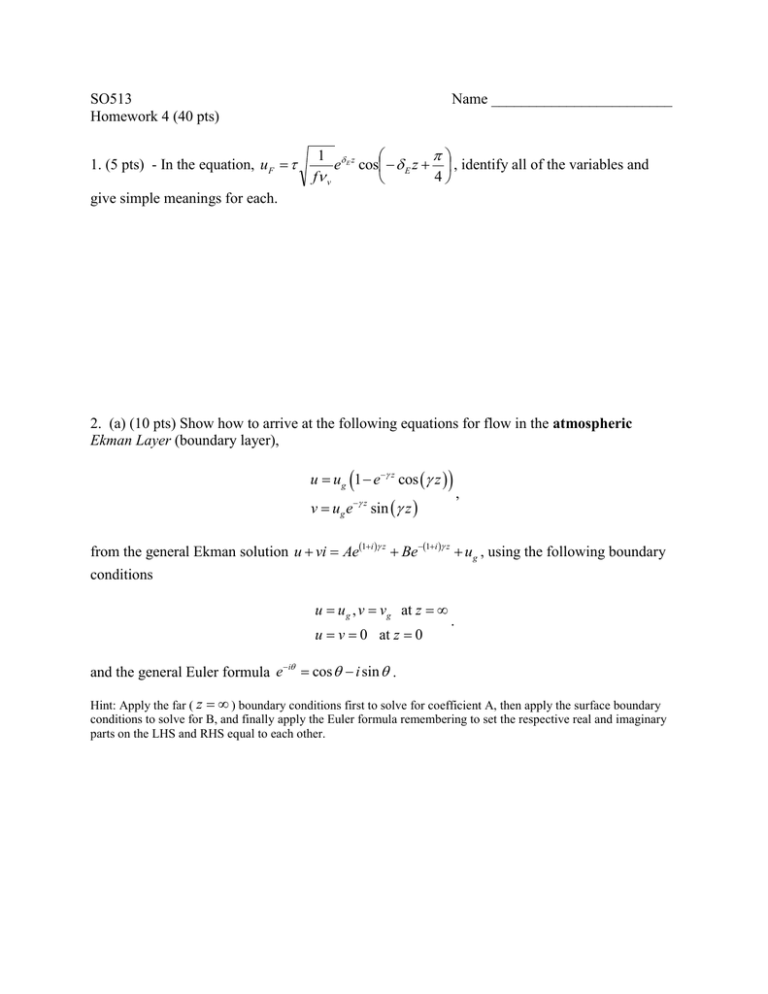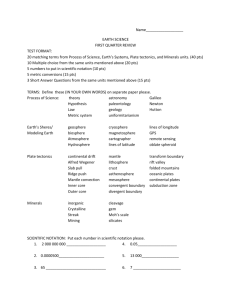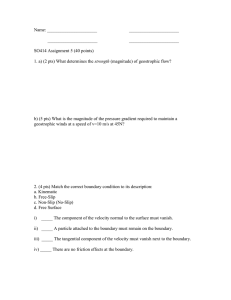SO513 Name ________________________ Homework 4 (40 pts)
advertisement

SO513 Homework 4 (40 pts) 1. (5 pts) - In the equation, u F Name ________________________ e E z cos E z , identify all of the variables and f v 4 1 give simple meanings for each. 2. (a) (10 pts) Show how to arrive at the following equations for flow in the atmospheric Ekman Layer (boundary layer), u ug 1 e z cos z v ug e z sin z from the general Ekman solution u vi Ae conditions 1i z , Be1i z ug , using the following boundary u u g , v vg at z u v 0 at z 0 . and the general Euler formula e i cos i sin . Hint: Apply the far ( z ) boundary conditions first to solve for coefficient A, then apply the surface boundary conditions to solve for B, and finally apply the Euler formula remembering to set the respective real and imaginary parts on the LHS and RHS equal to each other. Figure 1: Ekman spiral for the atmospheric boundary layer. Note the values along the x and y axes are ratios. Thus, at the point (1,0), the u component of the wind is exactly equal to its geostropic value, and the v component of the wind is zero. (b) (5 pts) Find the fractional values of u / u g and v / u g using the equations in part 5a for the following heights, and plot the heights on Figure 1 above. Show your work below the table. z u / ug v / ug 6 z 3 z 2 z 2 3 z z 3 2 z 2 (c) (5 pts) Calculate the height (z) where the mean wind is nearly zonal and geostrophic (show your work). This height is designated as the top of the Ekman Layer, and the layer is commonly called the “boundary layer”, as it is the boundary between the free troposphere above and the surface below. It is often marked by the presence of a strong temperature inversion, and if substantial scalar tracers are present at the surface (including water vapor, pollution, and even insects), these elements are often thoroughly mixed through the boundary layer. 1 f 2 (d) (5 pts) The parameter is defined as , and K m is the vertical eddy viscosity 2Km which is a measure of mixing in the boundary layer. It is itself defined as a ratio between u vertical turbulent flux of horizontal momentum ( uw ) and vertical shear of the mean wind ( ): z uw Km . Eddy diffusivities have been observed to range from 1 102 m2 s 1 . Calculate the u / z range of boundary layer depths (using your solution from part c) that correspond to this range in eddy diffusivities. Assume a typical mid-latitude value for f. ( f 104 s 1 ) (e) (5 pts) What does this range (in boundary layer depth) imply about the role of turbulence and vertical shear in determining the depth of the atmospheric boundary layer? (f) (2 pts) At night, turbulent momentum transport typically decreases (due to loss of convective heat transfer) but vertical shear increases (especially as near-surface winds go calm while flow just above the surface remains relatively fast). What then can you infer about the typical height of the atmospheric boundary layer at night? (g) (3 pts) Finally, if the surface is characterized by many pollution sources, use K-theory (the shorthand name given to this work by Prandtl and Ekman) to explain why pollution concentrations are typically highest at sunrise and lowest in the late afternoon.




